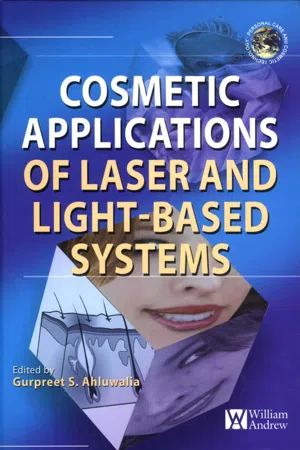
- 500 pages
- English
- ePUB (mobile friendly)
- Available on iOS & Android
Cosmetics Applications of Laser and Light-Based Systems
About This Book
In recent decades, cosmetic science has found new high-potency, bioactive ingredients that produce visibly superior skin benefits to the consumer. Light-based devices, including lasers and intense-pulsed light systems, have been used for years in the treatment of cutaneous vascular and pigmented lesions, yet have only recently appeared in cosmetic applications, beauty salons and spas. Meanwhile, ever more research and development is being performed with the intent of bringing them to the home-use market.
This book is the first to introduce a range of currently used, or under development, laser- and light-based technologies that will provide greater cosmetic benefits to the consumer. It explains the basic physics of light-based technologies, the bio-physical principles behind their mechanism of action, and their applications in many cosmetic procedures. The fundamentals of skin and hair physiology (relevant to the understanding of actions of various cosmetics) are also explained, as are: cosmeceuticals; topical drugs for cosmetic benefits; non-invasive and invasive options available for beauty treatments, and how all this fits in with the emerging light-based technologies.
Individual chapters are devoted to the various skin and hair conditions where light-based systems are currently used. Treatments discussed include the rejuvenation and toning of damaged skin; skin resurfacing and microdermabrasion; hair removal and growth reduction; wrinkle reduction; acne treatment and cellulite. Finally, the book examines the synergy of cosmeceuticals and topical bioactive agents with light-based technologies, safety issues, a regulatory perspective for OTC marketing, and concludes with a discussion of the business aspects related to home-use of light-based devices.
- The first book to introduce this emerging technology to the personal care industry
- Explains their applications in many cosmetic procedures
- Devotes individual chapters to common skin and hair conditions
Frequently asked questions
Information
Chapter 1 The Biology of Hair Growth
- 1.1 Introduction 4
- 1.2 The Functions of Hair 4
- 1.3 Hair Follicle Anatomy 7
- 1.3.1 The Hair Shaft 7
- 1.3.2 The Inner Root Sheath 7
- 1.3.3 The Outer Root Sheath 7
- 1.3.4 The Dermal Papilla 8
- 1.4 Changing the Hair Produced by a Follicle via the Hair Growth Cycle 9
- 1.4.1 Telogen-The Resting Phase 10
- 1.4.2 Anagen-The Growth Phase 11
- 1.4.3 Catagen-The Regressive Phase 11
- 1.4.4 Exogen-Hair Shedding 13
- 1.5 Hair Pigmentation 13
- 1.6 Seasonal Changes in Hair Growth 15
- 1.6.1 Hormonal Coordination of Seasonal Changes in Animals 15
- 1.6.2 Seasonal Variation in Human Hair Growth 16
- 1.7 Hormonal Regulation of Human Hair Growth 18
- 1.7.1 Pregnancy 18
- 1.7.2 Androgens 18
- 1.7.2.1 Human Hair Follicles Show Paradoxically Different Intrinsic Responses to Androgens 18
- 1.7.2.2 The Mechanism of Androgen Action in Hair Follicles 21
- 1.8 Treatment of Hair Growth Disorders 25
- References 26
1.1 Introduction
1.2 The Functions of Hair

Table of contents
- Cover
- Title Page
- Personal Care and Cosmetic Technology
- Copyright
- Dedication
- Table of Contents
- Contributors
- Preface
- Part 1- Basic Technology and Targets for Light-Based Systems
- Part 2 - Hair Management by Light-Based Technologies
- Part 3 - Light-Based Systems for Improving Skin Appearance
- Part 4 - Treatment of Skin and Hair Disorders Using Light-Based Technologies
- Part 5 - Synergy of Bioactive Molecules with Light Energy
- Part 6 - Regulatory and Safety Guidance
- Index
- Personal Care and Cosmetic Technology Series